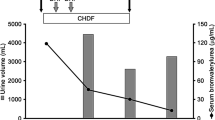Abstract
Since superwarfarin is popular and readily available in stores, it may cause intoxication or overexposure, which can result in coagulopathy or abnormal bleeding in humans and, thus, is an important public health problem. We report our clinical experience with superwarfarin intoxication. Nine patients, including eight patients who had histories of ingesting superwarfarin, were studied. Of the patients, hematuria occurred in eight. Laboratory tests among the nine patients showed extremely prolonged prothrombin times and activated partial thromboplastin times, which could be corrected to normal by mixing 1:1 with normal pooled plasma; they also had very low functional levels of factor II, VII, IX, X, and proteins C and S, but normal functional levels of factors V, VIII, fibrinogen, and anti-thrombin III. Large doses of vitamin K1 were needed for 3 months or more to treat and correct the coagulopathy among the patients. The majority of the patients presented with gross hematuria, suggesting that hematuria is probably a major clinical manifestation of superwarfarin intoxication. Prolonged use of large doses of vitamin K1 is needed for the treatment of superwarfarin intoxication.
Similar content being viewed by others
References
Hadler MR, Shadbolt RS. Novel 4-hydroxycoumarin anticoagulants active against resistant rats. Nature. 1975;253:275–7.
Lund M. Comparative effect of the three rodenticides warfarin, difenacoum and brodifacoum on eight rodent species in short feeding periods. J Hyg (Lond). 1981;87:101–7.
Park BK, Leck JB. A comparison of vitamin K antagonism by warfarin, difenacoum and brodifacoum in the rabbit. Biochem Pharmacol. 1982;31:3635–9.
Berry RG, Morrison JA, Watts JW, Anagnost JW, Gonzalez JJ. Surreptitious superwarfarin ingestion with brodifacoum. South Med J. 2000;93:74–5.
Chua JD, Friedenberg WR. Superwarfarin poisoning. Arch Int Med. 1998;158:1929–32.
Spahr JE, Maul JS, Rodgers GM. Superwarfarin poisoning: a report of two cases and review of the literature. Am J Hematol. 2007;82:656–60.
Watson WA, Litovitz TL, Rodgers GC Jr, Klein-Schwartz W, Reid N, Youniss J, et al. 2004 Annual report of the American Association of Poison Control Centers Toxic Exposure Surveillance System. Am J Emerg Med. 2005;23:589–666.
Pavlu J, Harrington DJ, Voong K, Savidge GF, Jan-Mohamed R, Kaczmarski R. Superwarfarin poisoning. Lancet. 2005;365:628.
Lipton RA, Klass EM. Human ingestion of a ‘superwarfarin’ rodenticide resulting in a prolonged anticoagulant effect. JAMA. 1984;252:3004–5.
Litovitz TL, Smilkstein M, Felberg L, Klein-Schwartz W, Berlin R, Morgan JL. 1996 annual report of the American Association of Poison Control Centers Toxic Exposure Surveillance System. Am J Emerg Med. 1997;15:447–500.
Litovitz TL, Felberg L, White S, Klein-Schwartz W. 1995 annual report of the American Association of Poison Control Centers Toxic Exposure Surveillance System. Am J Emerg Med. 1996;14:487–537.
Sarin S, Mukhtar H, Mirza MA. Prolonged coagulopathy related to superwarfarin overdose. Ann Int Med. 2005;142:156.
Zupancic-Salek S, Kovacevic-Metelko J, Radman I. Successful reversal of anticoagulant effect of superwarfarin poisoning with recombinant activated factor VII. Blood Coagul Fibrinol. 2005;16:239–44.
Acknowledgments
The authors thank Changhua Christian Hospital for their support (CCH 93113). We are grateful to Mei-Fua Hong and Su-Feng Kuo for technical assistance.
Author information
Authors and Affiliations
Corresponding author
About this article
Cite this article
Wu, YF., Chang, CS., Chung, CY. et al. Superwarfarin intoxication: hematuria is a major clinical manifestation. Int J Hematol 90, 170–173 (2009). https://doi.org/10.1007/s12185-009-0374-6
Received:
Revised:
Accepted:
Published:
Issue Date:
DOI: https://doi.org/10.1007/s12185-009-0374-6




